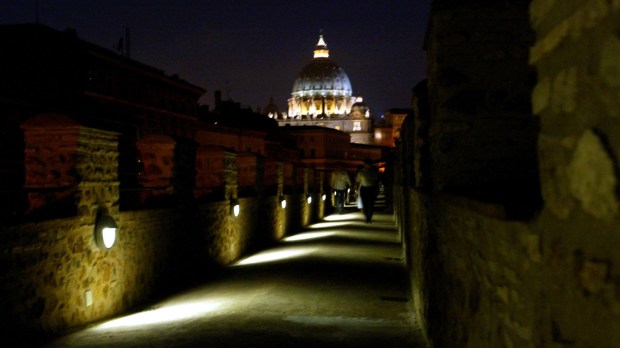There is an interesting corridor embedded in the only medieval wall of Rome left, connecting the Vatican Apostolic Palace to Castel Sant’Angelo, on the banks of the Tiber River, dating from the 13th century.
The “last escape route of the popes,” this underground passage is a kind of ghost that, with numerous inaccuracies, astonishes the imagination of many writers. For example, it was during writer Dan Brown’s visit to that little corridor when he had the idea to write his bestselling Angels and Demons, a fanciful fiction that turns the Vatican into a stage of extravagant conspiracies.
The American writer claims the passage is about 400 meters long and reaches the pope’s private library. In fact, the route is 800 meters long and ends near the papal residence, above the current headquarters of the Vatican couriers.
One of the rare medieval vestiges of Rome, this passage was built from a small wall erected by the kings of the Ostrogoths, who invaded Rome in 546. The wall, at the time, connected the lower part of the Vatican Hill to the mausoleum of Hadrian, later to be known as the Castel Sant’Angelo.
On the foundation of the Ostrogoth wall, Leo IV built, at the beginning of his pontificate, a true protective wall for the old Vatican Basilica, which had been sacked by the Saracens in 846. The wall, built by Saracen prisoners and Corsican immigrants, crosses the hill and is oriented towards the river. In those days, heavy currents blocked the passage of boats, adding to the defense.
A first passage in the wall was made by order of Nicholas III, who decided to make the Vatican Palace the residence of the pope (previously, the papal residence was at the Lateran Palace) and installed his family in the Castel Sant’Angelo. In the 15th century, the existing escape route was transformed into a double passage: the lower part, covered and protected by defense devices, was reserved for the pope; the upper part, for the papal troops.
Although many people like to think of this passage as the site of different kinds of “escapades” the corridor is, in fact, only an escape route used in strict emergencies. For instance, Alexander VI, the famous Borgia Pope, used it in 1494 to take refuge in Castel Sant’Angelo when the French troops of King Charles VIII invaded Rome.
On May 6, 1527, the Protestant factions of Charles V sacked Rome: 147 Swiss guards died trying to protect Peter’s tomb, while another 42 protected Pope Clement VII who, crossing the emergency passage, took refuge in the castle. Since then, on the 6th of May of each year, the Swiss guards take an oath of fidelity to their duty and pay homage to their heroic predecessors.

